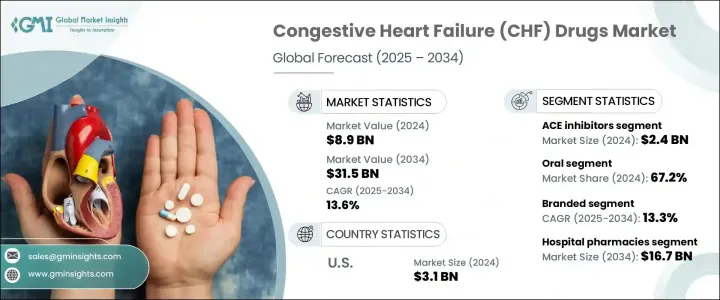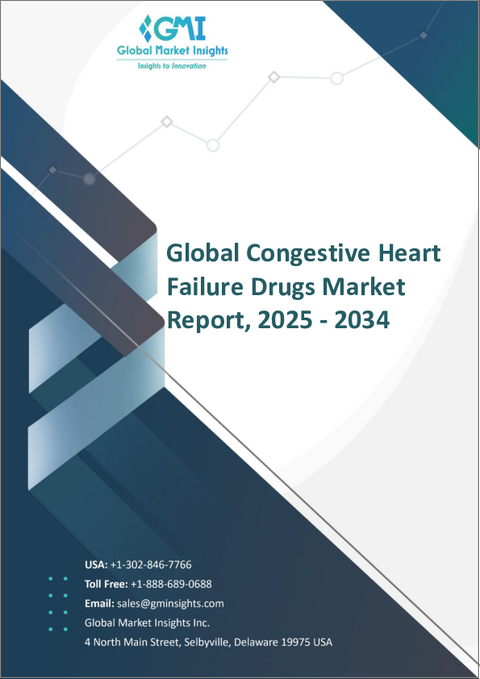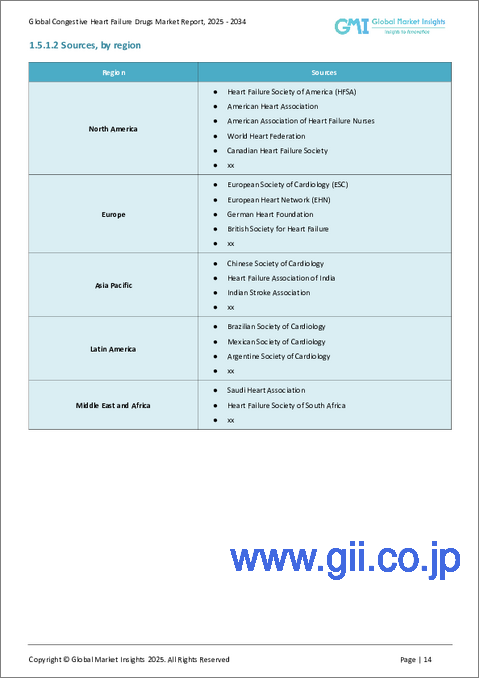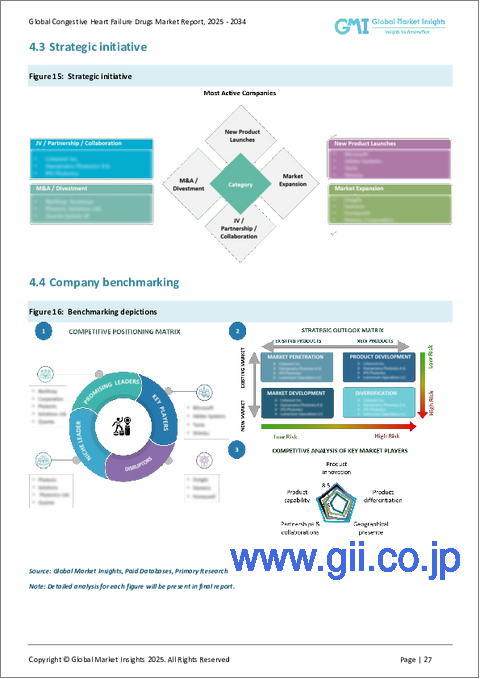|
|
市場調査レポート
商品コード
1750345
うっ血性心不全治療薬の市場機会、成長促進要因、産業動向分析、2025年~2034年予測Congestive Heart Failure Drugs Market Opportunity, Growth Drivers, Industry Trend Analysis, and Forecast 2025 - 2034 |
||||||
カスタマイズ可能
|
|||||||
| うっ血性心不全治療薬の市場機会、成長促進要因、産業動向分析、2025年~2034年予測 |
|
出版日: 2025年05月13日
発行: Global Market Insights Inc.
ページ情報: 英文 137 Pages
納期: 2~3営業日
|
全表示
- 概要
- 目次
世界のうっ血性心不全(CHF)治療薬市場は2024年に89億米ドルと評価され、CAGR 13.6%で成長し、2034年には315億米ドルに達すると推定されます。
人口動態の高齢化と高血圧、肥満、糖尿病などの疾患の罹患率の上昇によって、心不全の世界の負担が増加していることが、市場の成長に大きく寄与しています。人口の高齢化と慢性的な健康状態の蔓延に伴い、心不全の長期的な治療ソリューションに対するニーズは高まり続けています。この動向は、ヘルスケアインフラへのアクセスが拡大し、心血管の健康に対する意識が高まっている地域で特に顕著です。診断能力が向上し、予防医療が重視されるようになったことで、CHFの早期診断と治療がより現実的になっています。

また、急性型と慢性型の両方に焦点を当てた研究開発が活発化していることも、市場を後押ししています。製薬会社が新薬開発への投資を強化する中、CHF治療の全体的な展望は急速に進展しています。加えて、ヘルスケア政策、医薬品アクセスの改善、幅広い治療薬の組み合わせが、市場の着実な成長を後押ししています。また、市場各社はパートナーシップや戦略的提携、規制当局の承認を活用して製品ポートフォリオを強化し、世界展開を強化しており、長期的な市場成長をさらに後押ししています。
| 市場範囲 | |
|---|---|
| 開始年 | 2024 |
| 予測年 | 2025-2034 |
| 開始金額 | 89億米ドル |
| 予測金額 | 315億米ドル |
| CAGR | 13.6% |
薬理学的進歩は、CHF治療プロトコルの再定義に大きな役割を果たしています。β遮断薬、ACE阻害薬、利尿薬といった従来型の治療が依然としてCHF治療の基本である一方、新しい薬剤クラス別が臨床的有用性で台頭しつつあります。アンジオテンシン受容体-ネプリライシン阻害薬(ARNI)とナトリウム-グルコース共輸送体-2(SGLT2)阻害薬は、患者の予後を改善する上で大きな進歩を遂げています。これらの新規治療薬は、広範な臨床研究によって裏付けられ、入院率や死亡率の低下に有望であることが示されており、ヘルスケアプロバイダーと患者の双方にとって魅力的な選択肢となっています。現在進行中の臨床試験と技術革新により、これらの新しい治療法はヘルスケアシステム全体でCHFの管理方法を再構築しつつあります。
薬剤クラス別に見ると、市場にはβ遮断薬、ACE阻害薬、利尿薬、ミネラルコルチコイド受容体拮抗薬(MRA)、アンジオテンシン2受容体拮抗薬、イバブラジン、SGLT2阻害薬、強心薬、その他が含まれます。2024年には、ACE阻害薬セグメントが24億米ドルの評価額で市場をリードしました。駆出率が低下した心不全の管理におけるACE阻害薬の役割は古くから確立されており、入院を減らし生存率を向上させる能力も証明されていることから、ACE阻害薬の関連性は高いです。これらの薬剤は、手頃な価格、ブランドおよびジェネリック医薬品としての幅広い入手可能性、世界各地の治療ガイドラインにおける一貫した承認により、広く処方されています。
CHF治療薬市場は、投与経路別に経口剤と非経口剤に区分されます。経口剤は2024年に市場の67.2%を占めました。その利便性、使いやすさ、手頃な価格から、CHFの長期管理には経口薬が望ましい選択肢となっています。一般的に使用されているCHF治療薬のほとんどが経口剤であるため、高所得国でも低所得国でも患者のアドヒアランスが向上し、費用対効果の高い疾患管理が可能になります。
薬剤の種類別では、市場はブランド薬とジェネリック医薬品に分けられます。ブランド薬セグメントは、2034年までのCAGRが13.3%と予測されています。この成長の背景には、有効性と安全性を高めた革新的な治療法の導入があります。ヘルスケアプロバイダーは、その広範な臨床検証によりブランド薬を好むことが多く、また世界の医療支出の増加が新興国市場でのブランド薬の普及を支えています。
CHF治療薬市場の流通チャネル別には、病院薬局、小売薬局、オンライン薬局などがあります。病院薬局は2034年までに167億米ドルに達すると予測されています。この成長の原動力は、一般的に外来では受けられない点滴や専門的な治療を行う上で、病院が果たす重要な役割です。治療アプローチが複雑化するにつれ、病院はCHFの先進治療を提供する上でますます中心的な存在となっています。
地域別では、北米が2024年のCHF治療薬市場を38.5%のシェアで牽引しました。特に米国は、心不全治療に対する旺盛な需要を反映して、2024年に31億米ドルの売上を記録しました。同国の確立されたヘルスケア・インフラ、保険による医薬品への幅広いアクセス、高い認知度が、市場をリードする要因となっています。
市場競争は依然として激しく、アストラゼネカ、ノバルティス、バイエル、イーライリリー、ベーリンガーインゲルハイム、メルクといった大手企業が世界市場の約45%を占めています。これらの企業は、技術革新を推進し、規制状況のマイルストーンを追求し、進化する治療状況において優位性を維持するために地域的な拡大を続けています。
目次
第1章 調査手法と範囲
第2章 エグゼクティブサマリー
第3章 業界考察
- エコシステム分析
- 業界への影響要因
- 促進要因
- 心不全の有病率の上昇
- 医薬品開発の進歩
- 意識向上とスクリーニング
- 業界の潜在的リスク&課題
- 厳格な規制承認
- 先進医療の高コスト
- 促進要因
- 成長可能性分析
- 規制情勢
- トランプ政権による関税への影響
- 貿易への影響
- 貿易量の混乱
- 報復措置
- 業界への影響
- 供給側の影響(原材料)
- 主要原材料の価格変動
- サプライチェーンの再構築
- 生産コストへの影響
- 需要側の影響(販売価格)
- 最終市場への価格伝達
- 市場シェアの動向
- 消費者の反応パターン
- 供給側の影響(原材料)
- 影響を受ける主要企業
- 戦略的な業界対応
- サプライチェーンの再構成
- 価格設定と製品戦略
- 政策関与
- 展望と今後の検討事項
- 貿易への影響
- パイプライン分析
- ポーター分析
- PESTEL分析
第4章 競合情勢
- イントロダクション
- 企業マトリックス分析
- 主要市場企業の競合分析
- 競合ポジショニングマトリックス
- 戦略ダッシュボード
第5章 市場推計・予測:薬剤クラス別、2021-2034
- 主要動向
- ACE阻害薬
- ベータ遮断薬
- 利尿剤
- アンジオテンシン2受容体遮断薬
- ミネラルコルチコイド受容体拮抗薬(MRA)
- イバブラジン
- 強心薬
- SGLT2阻害剤
- その他の薬物クラス
第6章 市場推計・予測:投与経路別、2021-2034
- 主要動向
- 経口
- 非経口
第7章 市場推計・予測:薬剤の種類別、2021-2034
- 主要動向
- ブランド
- ジェネリック
第8章 市場推計・予測:流通チャネル別、2021-2034
- 主要動向
- 病院薬局
- 小売薬局
- オンライン薬局
第9章 市場推計・予測:地域別、2021-2034
- 主要動向
- 北米
- 米国
- カナダ
- 欧州
- ドイツ
- 英国
- フランス
- イタリア
- スペイン
- オランダ
- アジア太平洋地域
- 中国
- 日本
- インド
- オーストラリア
- 韓国
- ラテンアメリカ
- ブラジル
- メキシコ
- アルゼンチン
- 中東・アフリカ
- 南アフリカ
- サウジアラビア
- アラブ首長国連邦
第10章 企業プロファイル
- Alnylam Pharmaceuticals
- Amgen
- AstraZeneca
- Bayer
- Boehringer Ingelheim International
- Bristol-Myers Squibb Company
- Eli Lilly and Company
- GlaxoSmithKline
- Johnson &Johnson
- Merck
- Novartis
- Otsuka Pharmaceutical
- Pfizer
- Sanofi
- Teva Pharmaceutical Industries
The Global Congestive Heart Failure Drugs Market was valued at USD 8.9 billion in 2024 and is estimated to grow at a CAGR of 13.6% to reach USD 31.5 billion by 2034. The increasing global burden of heart failure, driven by aging demographics and the rising incidence of conditions like hypertension, obesity, and diabetes, is significantly contributing to market growth. As the population ages and chronic health conditions become more prevalent, the need for long-term treatment solutions for heart failure continues to grow. This trend is especially prominent in regions with growing access to healthcare infrastructure and increasing awareness of cardiovascular health. Early diagnosis and treatment of CHF are now more feasible thanks to improved diagnostic capabilities and a growing emphasis on preventive care.

The market is also being bolstered by an uptick in research and development activities focused on both acute and chronic forms of the disease. With pharmaceutical companies ramping up investments in new drug development, the overall landscape for CHF treatment is rapidly evolving. Additionally, the combination of supportive healthcare policies, improved drug accessibility, and a wider therapeutic arsenal is reinforcing the market's steady rise. Market players are also leveraging partnerships, strategic alliances, and regulatory approvals to strengthen their product portfolios and enhance global reach, further fueling long-term market growth.
| Market Scope | |
|---|---|
| Start Year | 2024 |
| Forecast Year | 2025-2034 |
| Start Value | $8.9 Billion |
| Forecast Value | $31.5 Billion |
| CAGR | 13.6% |
Pharmacological advancements are playing a major role in redefining CHF treatment protocols. While conventional therapies like beta blockers, ACE inhibitors, and diuretics remain fundamental in managing the disease, newer classes of drugs are gaining ground for their clinical benefits. Angiotensin receptor-neprilysin inhibitors (ARNIs) and sodium-glucose cotransporter-2 (SGLT2) inhibitors are making significant strides in improving patient outcomes. These novel therapies are supported by extensive clinical research and have shown promise in reducing hospitalization and mortality rates, making them an attractive option for both healthcare providers and patients. With ongoing clinical trials and innovation, these newer treatments are reshaping how CHF is managed across healthcare systems.
Based on drug class, the market includes beta blockers, ACE inhibitors, diuretics, mineralocorticoid receptor antagonists (MRAs), angiotensin 2 receptor blockers, ivabradine, SGLT2 inhibitors, inotropes, and others. In 2024, the ACE inhibitors segment led the market with a valuation of USD 2.4 billion. Their long-established role in managing heart failure with reduced ejection fraction, combined with their proven ability to reduce hospital admissions and enhance survival, keeps them highly relevant. These drugs are widely prescribed due to their affordability, broad availability in branded and generic formats, and consistent endorsement in treatment guidelines worldwide.
By route of administration, the CHF drugs market is segmented into oral and parenteral formulations. Oral drugs accounted for 67.2% of the market in 2024. Their convenience, ease of use, and affordability make them the preferred option for long-term management of CHF. Most commonly used CHF medications are available in oral formulations, promoting patient adherence and cost-effective disease management across both high- and low-income countries.
In terms of drug type, the market is divided into branded and generic drugs. The branded drugs segment is forecasted to grow at a CAGR of 13.3% through 2034. This growth is attributed to the introduction of innovative therapies that offer enhanced efficacy and safety profiles. Healthcare providers often prefer branded medications due to their extensive clinical validation, while increasing global healthcare spending supports their uptake in developed markets.
The distribution channels in the CHF drugs market include hospital pharmacies, retail pharmacies, and online pharmacies. Hospital pharmacies are projected to reach USD 16.7 billion by 2034. This growth is driven by the critical role hospitals play in administering intravenous medications and specialized treatments that are typically not available in outpatient settings. As treatment approaches become more complex, hospitals are increasingly central to the delivery of advanced CHF therapies.
Geographically, North America led the CHF drugs market in 2024 with a 38.5% share. The United States, in particular, recorded revenue of USD 3.1 billion in 2024, reflecting strong demand for heart failure treatments. The country's well-established healthcare infrastructure, wide access to medications through insurance, and high awareness levels contribute to its leading market position.
The market remains highly competitive, with major players like AstraZeneca, Novartis, Bayer, Eli Lilly, Boehringer Ingelheim, and Merck collectively holding around 45% of the global market. These companies continue to drive innovation, pursue regulatory milestones, and expand regionally to maintain their edge in the evolving treatment landscape.
Table of Contents
Chapter 1 Methodology and Scope
- 1.1 Market scope and definition
- 1.2 Research design
- 1.2.1 Research approach
- 1.2.2 Data collection methods
- 1.3 Base estimates and calculations
- 1.3.1 Base year calculation
- 1.3.2 Key trends for market estimation
- 1.4 Forecast model
- 1.5 Primary research and validation
- 1.5.1 Primary sources
- 1.5.2 Data mining sources
Chapter 2 Executive Summary
- 2.1 Industry 3600 synopsis
Chapter 3 Industry Insights
- 3.1 Industry ecosystem analysis
- 3.2 Industry impact forces
- 3.2.1 Growth drivers
- 3.2.1.1 Rising prevalence of heart failure
- 3.2.1.2 Advancements in drug development
- 3.2.1.3 Increasing awareness and screening
- 3.2.2 Industry pitfalls and challenges
- 3.2.2.1 Stringent regulatory approval
- 3.2.2.2 High cost of advanced medications
- 3.2.1 Growth drivers
- 3.3 Growth potential analysis
- 3.4 Regulatory landscape
- 3.5 Trump administration tariffs
- 3.5.1 Impact on trade
- 3.5.1.1 Trade volume disruptions
- 3.5.1.2 Retaliatory measures
- 3.5.2 Impact on the industry
- 3.5.2.1 Supply-side impact (raw materials)
- 3.5.2.1.1 Price volatility in key materials
- 3.5.2.1.2 Supply chain restructuring
- 3.5.2.1.3 Production cost implications
- 3.5.2.2 Demand-side impact (selling price)
- 3.5.2.2.1 Price transmission to end markets
- 3.5.2.2.2 Market share dynamics
- 3.5.2.2.3 Consumer response patterns
- 3.5.2.1 Supply-side impact (raw materials)
- 3.5.3 Key companies impacted
- 3.5.4 Strategic industry responses
- 3.5.4.1 Supply chain reconfiguration
- 3.5.4.2 Pricing and product strategies
- 3.5.4.3 Policy engagement
- 3.5.5 Outlook and future considerations
- 3.5.1 Impact on trade
- 3.6 Pipeline analysis
- 3.7 Porter's analysis
- 3.8 PESTEL analysis
Chapter 4 Competitive Landscape, 2024
- 4.1 Introduction
- 4.2 Company matrix analysis
- 4.3 Competitive analysis of major market players
- 4.4 Competitive positioning matrix
- 4.5 Strategy dashboard
Chapter 5 Market Estimates and Forecast, By Drug Class, 2021 - 2034 ($ Mn)
- 5.1 Key trends
- 5.2 ACE inhibitors
- 5.3 Beta blockers
- 5.4 Diuretics
- 5.5 Angiotensin 2 receptor blockers
- 5.6 Mineralocorticoid receptor antagonists (MRAs)
- 5.7 Ivabradine
- 5.8 Inotropes
- 5.9 SGLT2 inhibitors
- 5.10 Other drug classes
Chapter 6 Market Estimates and Forecast, By Route of Administration, 2021 - 2034 ($ Mn)
- 6.1 Key trends
- 6.2 Oral
- 6.3 Parenteral
Chapter 7 Market Estimates and Forecast, By Type, 2021 - 2034 ($ Mn)
- 7.1 Key trends
- 7.2 Branded
- 7.3 Generic
Chapter 8 Market Estimates and Forecast, By Distribution Channel, 2021 - 2034 ($ Mn)
- 8.1 Key trends
- 8.2 Hospital pharmacies
- 8.3 Retail pharmacies
- 8.4 Online pharmacies
Chapter 9 Market Estimates and Forecast, By Region, 2021 - 2034 ($ Mn)
- 9.1 Key trends
- 9.2 North America
- 9.2.1 U.S.
- 9.2.2 Canada
- 9.3 Europe
- 9.3.1 Germany
- 9.3.2 UK
- 9.3.3 France
- 9.3.4 Italy
- 9.3.5 Spain
- 9.3.6 Netherlands
- 9.4 Asia Pacific
- 9.4.1 China
- 9.4.2 Japan
- 9.4.3 India
- 9.4.4 Australia
- 9.4.5 South Korea
- 9.5 Latin America
- 9.5.1 Brazil
- 9.5.2 Mexico
- 9.5.3 Argentina
- 9.6 Middle East and Africa
- 9.6.1 South Africa
- 9.6.2 Saudi Arabia
- 9.6.3 UAE
Chapter 10 Company Profiles
- 10.1 Alnylam Pharmaceuticals
- 10.2 Amgen
- 10.3 AstraZeneca
- 10.4 Bayer
- 10.5 Boehringer Ingelheim International
- 10.6 Bristol-Myers Squibb Company
- 10.7 Eli Lilly and Company
- 10.8 GlaxoSmithKline
- 10.9 Johnson & Johnson
- 10.10 Merck
- 10.11 Novartis
- 10.12 Otsuka Pharmaceutical
- 10.13 Pfizer
- 10.14 Sanofi
- 10.15 Teva Pharmaceutical Industries






